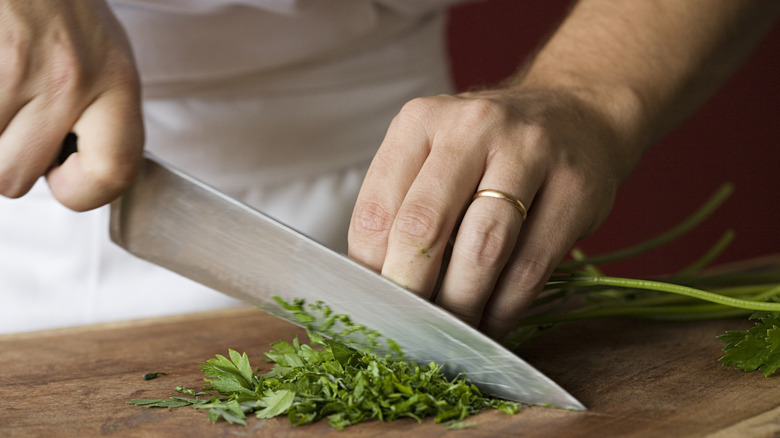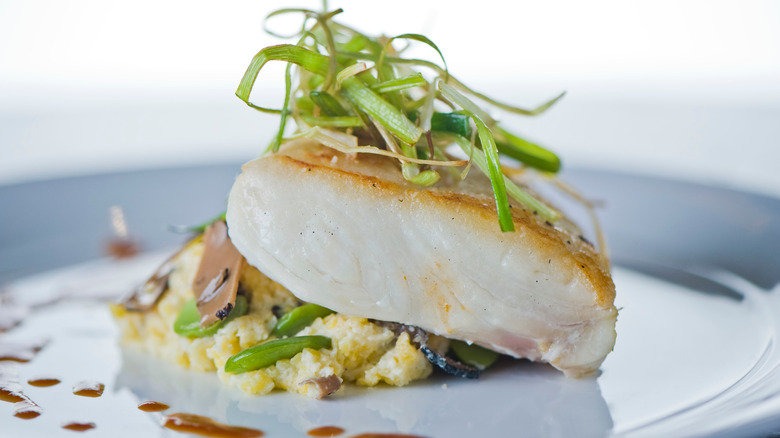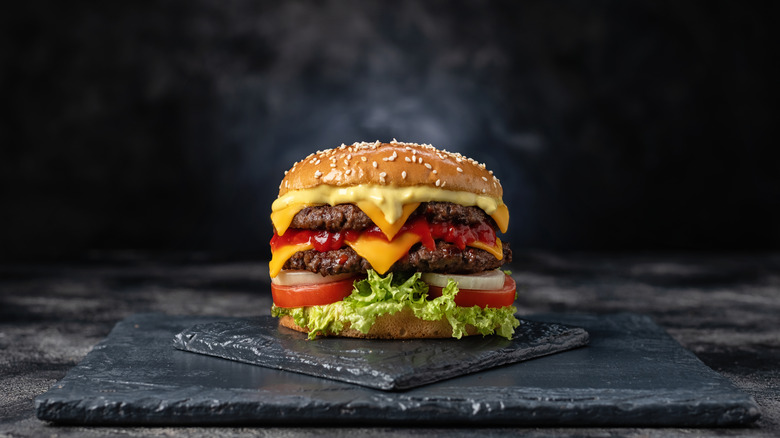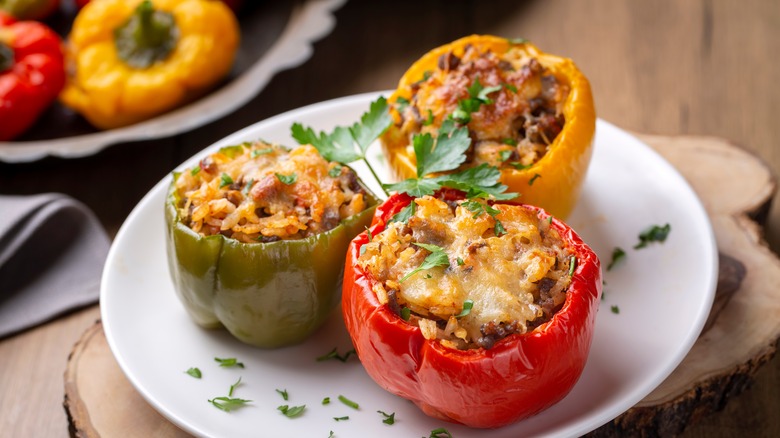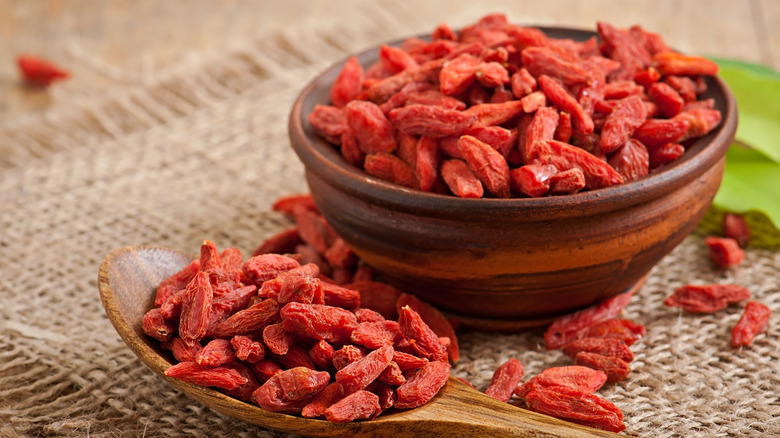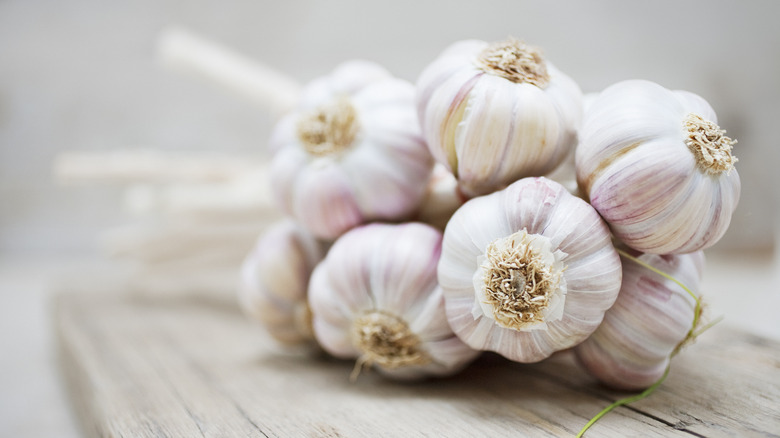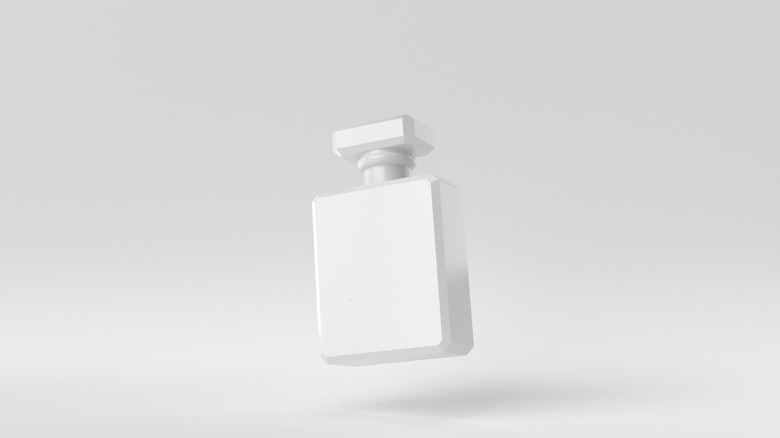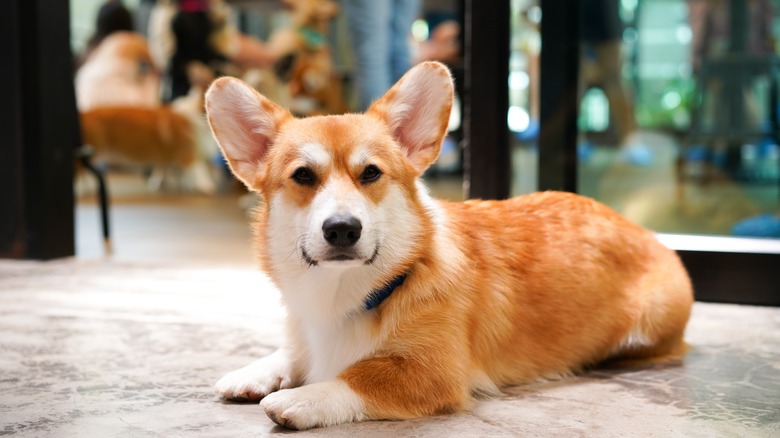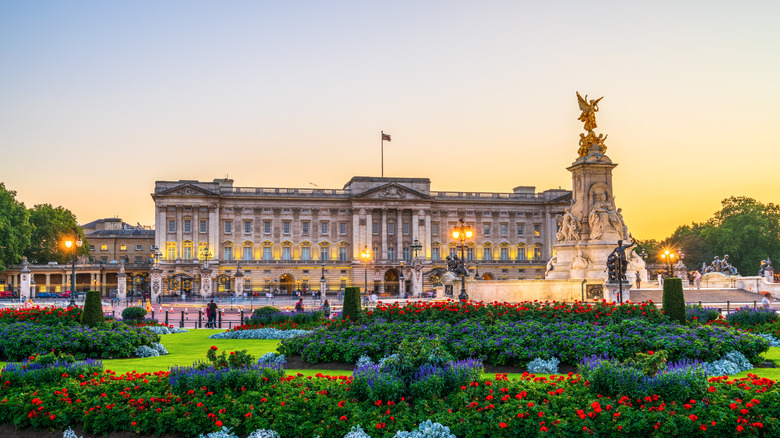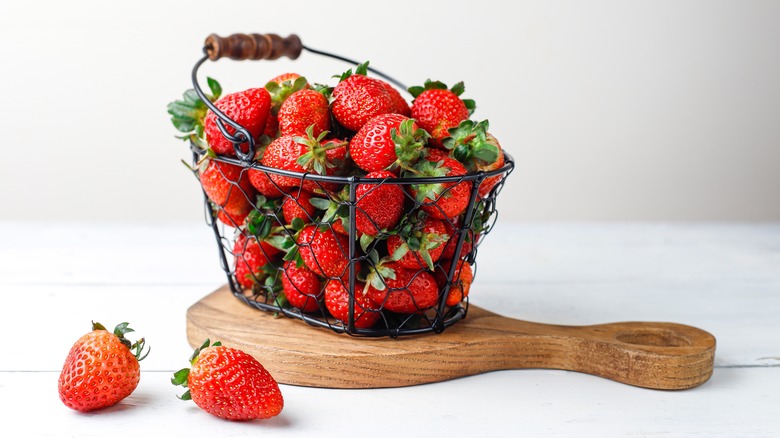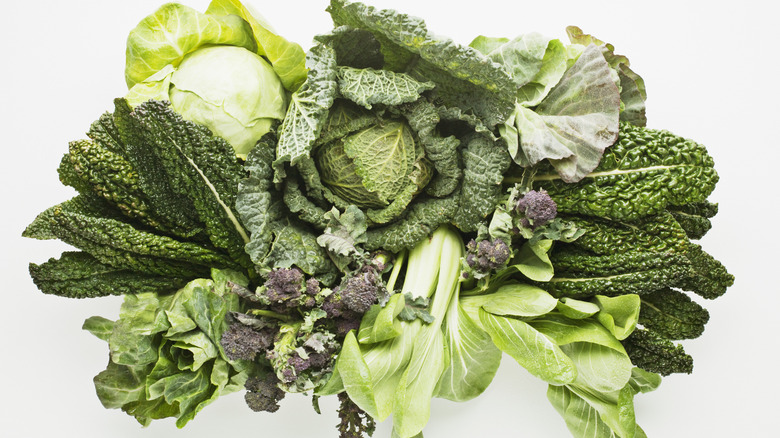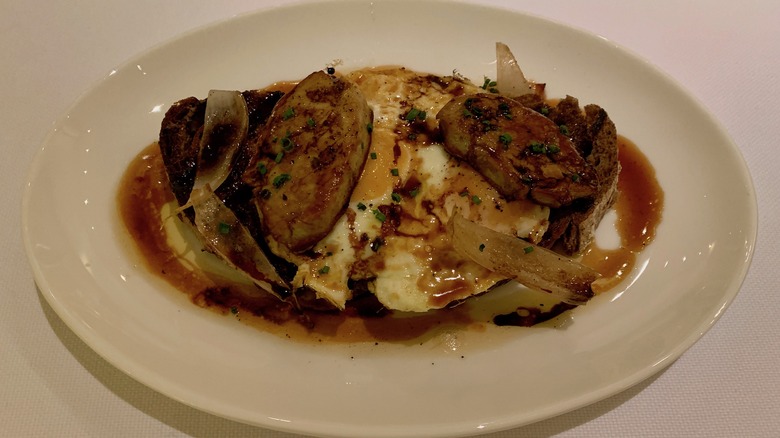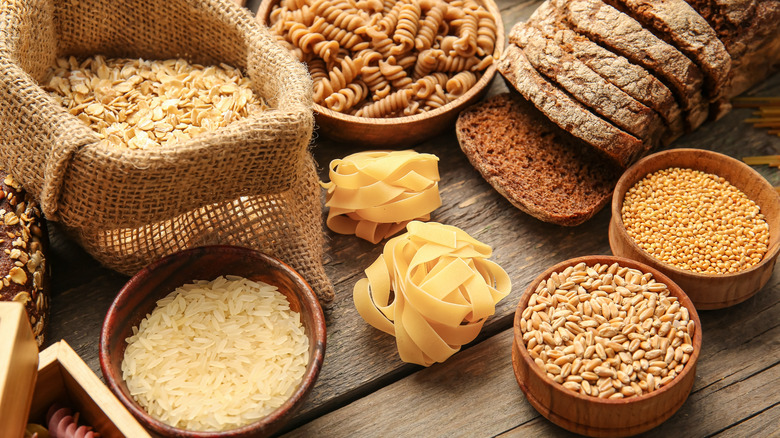Rules Chefs For The Royal Family Are Forced To Follow
Working as a private chef is a unique occupation. While it can be less stressful and more fruitful than working as a chef in a restaurant, being a private chef still comes with plenty of challenges, most often from the clients for whom the chefs are cooking, especially when those clients are wealthy, privileged, famous, or all three.
One family who's wealthy, privileged, and famous is the British royal family. The Windsors are perhaps the most well-known royals on the planet, and the inner workings of their lives are endlessly fascinating. Members of the royal family, as well as those in their orbit, have to follow a slew of bizarre rules, per Harper's Bazaar, and that extends to their eating habits as well. And because the members of the royal family don't cook for themselves, their private chefs have to meet particular standards. Let's dig a little deeper into the rules the chefs for the royal family are forced to follow.
The chefs primarily make French cuisine
It should come as a surprise to no one that the royal family prefers to eat the fanciest of the fancy cuisines. They are literal princes and princesses after all. And prior to Queen Elizabeth's death in 2022, the chefs were tasked with serving primarily French cuisine, staying away from foods that didn't fall under that umbrella. As Darren McGrady, a former royal chef, told Insider, "Eleven years at the palace and we never served pizza at all, not even at receptions. The menus at Buckingham Palace are very traditional French, which wouldn't lean towards having pizza on it." If you somehow make it inside the palace walls, don't expect a palatial pizza party.
Though we don't know what's on their exact week-to-week menu, given that the Windsors eat lots of French food, you can guess what some of their diets consist of. There are dozens of classic French dishes we imagine their chefs cooking on a regular basis, like a pot of boeuf bourguignon on a cold winter's night or a quiche Lorraine for a weekend brunch. McGrady did spill to Hello! one dish the Queen was particularly fond of, though. "We cooked a lot of traditional French food like halibut on a bed of spinach with a Morney sauce," he said.
The chefs had to recreate fast food for the Queen
People around the world love fast food, and it's no different in the United Kingdom. Per YouGov, 40% of the citizens on the island eat convenience food once a week. But Queen Elizabeth II reportedly wasn't asking her security detail to run her through a drive-thru. Instead, if the Queen wanted to eat fast food, her private chefs would cook their own versions. As former royal chef Darren McGrady told Insider, "It always tickled me at Balmoral, we would make our own burgers. They would shoot deer, and we would do venison burgers. There'd be gorgeous cranberry and everything stuffed into them."
The chefs had to follow another rule that affected their fast food reimaginations: no finger food. If the chefs served burgers, they did so sans one beloved ingredient. Per McGrady, "They would have burgers, but not the buns. So they would eat it with their knife and fork." While the chefs weren't digging into their stash of yeast to whip up fresh buns, they were serving the Queen another indulgent food quite often. As McGrady told Hello!, "She is absolutely a chocoholic. Anything we put on the menu that had chocolate on, she would choose, especially chocolate perfection pie." A devotion to chocolate is something we can relate to.
One chef had to make fat-free versions of food for Princess Diana
Being a private chef requires major sensitivity to the client's eating habits, particularly if one has an eating disorder. Princess Diana had bulimia, and the disorder affected the rules the chefs had to follow when cooking for her. As Darren McGrady told Marie Claire, "One day she said to me, 'Darren I want you to take care of all the fats, and I'll take care of the carbs at the gym.' We changed everything, I threw out my Buckingham Palace recipe book and got into healthy eating." McGrady added that some of the foods chefs cooked for Princess Di included stuffed bell peppers, stuffed eggplants, and fish.
Chefs also had to make fat-free versions of their dishes for Princess Di. While guests ate full-fat foods, Princess Diana ate substitutes. "She used to trick people: She'd say, 'Make me a mousse for President Reagan.' She couldn't have it because there was mayonnaise and sour cream. So she'd say 'Make me a fat-free version.' So I did," McGrady said.
If you need help with an eating disorder, or know someone who is, help is available. Visit the National Eating Disorders Association website or contact NEDA's Live Helpline at 1-800-931-2237. You can also receive 24/7 Crisis Support via text (send NEDA to 741-741).
The chefs had to seek approval from the Queen
Most private chefs have to seek menu approval from their clients, and the chefs for the Queen had to do the same. According to an interview with Darren McGrady, "At Buckingham Palace, we'd do a menu book that we'd send up to the Queen and she could choose the dishes she wanted. The book would come back to the kitchen and we'd prepare them. The Queen's menus are done three or more days ahead and she sticks with them religiously." The menus might have consisted of meat-heavy dishes. As McGrady told Hello!, "For a main course she loved game, things like Gaelic steak, fillet steak with a mushroom whisky sauce, especially if we did it with venison."
Of course, now that the Queen has passed, the chefs have to seek menu approval from someone else. According to Liverpool Echo, seeking approval from one member of the royal family might not be that difficult. Per a Twitter thread, Kate Middleton eats the same breakfast every day. The princess enjoys a breakfast of oats, and some of her other favorite foods include watermelon salad, goji berries, and vegetable lentil curry. We have to say, the princess has good taste.
Chefs can't use garlic
Cooking for the royal family means cooking the food they like, not experimenting to find the next greatest dish. Darren McGrady shared, "when you are cooking for the royal family, it's not like it's your restaurant ... So you have to prepare the food the way she likes it." And the Queen liked her food without garlic. Camilla Bowles even confirmed that the chefs couldn't use garlic in their cooking, sharing on "MasterChef Australia" that it can't be served because of the odor it leaves behind after it's been consumed (via Aol). No royal wants garlic-induced halitosis when talking to another head of state. We presume the rule has remained past the Queen's death considering its potency.
The Queen might have had another reason for not allowing chefs to put garlic in her food. As McGrady told Hello!, "The Queen never was a foodie. She always ate to live rather than live to eat ... if we had a new recipe, she'd have to look at the whole recipe before saying, 'Yes ok let's try it'. But for the most part she stuck to the same dishes week in week out."
None of the chefs are allowed to wear overpowering scents
Royal chefs are just like any other royal staff members, and that means they have to follow the same rules as other employees. As royal biographer Ingrid Seward told The Sun, the staff must be particular about the perfumes they wear. "Prince Philip once had a footman who used to wear a particular aftershave, and it used to make him feel quite ill ... I think he had to stop wearing it — they can't wear overpowering scents," Seward said. Should you find yourself working at Buckingham Palace one day, be sure to replace your soaps with unscented versions.
Per Darren McGrady, a former long-time chef for the Queen, a royal chef's demeanor is just as important as their scent. "I do think that when it comes to being a chef at the palace, 50% of actually becoming a chef there is your personality. Certainly in my days, because we had a very full nursery ... All the children could come into the kitchen at any time. And if we had 20 Gordon Ramsays running around the kitchen, swearing and shouting, that would not have worked," the insider shared in an interview. The personality aspect is probably just as important today. Although Prince Harry and Meghan Markle's children aren't making appearances in the kitchen anymore, Prince William and Kate Middleton still have three little ones running around.
The chefs had to make food for the Queen's dogs
Queen Elizabeth loved her corgis. Per the BBC, the royal had corgis almost her entire life, and these pups sure got the royal treatment. Not only did these dogs live in an actual palace, but they also had their own room at Buckingham. Former royal footman Steven Kaye told PureWow of the room, "It's quite regal — a great big dark wooden glossy door with a gold handle and beautifully polished floor with all these dog beds all over the place." But the posh life of the Queen's corgis didn't end with their digs — the dogs also ate just as well as their owner. As Darren McGrady told Insider, "I thought that when I started at the palace I'd be cooking for the Queen, and different presidents from around the world. But there I was, chopping rabbit for the royal corgis. In fact, the royal corgis had their own menu."
The corgis must have been in good health thanks to the chefs preparing rabbit for them. Per Smart Cookie Bakery, rabbit meat is a great food for dogs to consume. It's high in protein and low in cholesterol, and it's got a lot of vitamin B12, which can give dogs energy.
The live-in chefs have to separate themselves from the royals
Just because you live and work in royal quarters doesn't mean you get to rub shoulders with the royals themselves. The royal chefs have to maintain their distance from those they're serving, and the Windsors keep their staff in separate parts of the palace. "If you were a chef or a footman and you were trying to sneak up to the housemaids' floor and you got caught, you were in serious trouble. Everyone was segregated, it was the done thing," Darren McGrady told Insider, even comparing the living arrangements to those depicted in "Downton Abbey." He added that the servants' quarters were also divided by gender. "We were part of the Victorian era. You couldn't even begin to imagine single males and single females being on the same floor together," he said.
The chefs also have to refrain from speaking to their employers unless spoken to. Per The Sun, Peter Russell, a former royal footman said on YouTube, "The best servant is one that is neither seen nor heard." He added, "They want you there, but they don't want you there. They want you there because you have to be there. They want you there because they can't manage without you."
Chefs serve seasonal produce
If we could all exclusively eat seasonal produce, wouldn't we? Per Seasonal Food Guide, seasonal food has greater nutritional value than stuff that is out of season, and it'll taste better, too. Unfortunately, there are myriad accessibility issues when it comes to consuming seasonal fruit, making it nearly impossible for most people to only eat according to that standard. But the royals live unlike everyone else in the world, and because they have access to the best of the best, they're able to adapt their diets to what's healthiest. As reported by the Daily Mail, Darren McGrady said that the Queen would only eat seasonal produce, adding that she wouldn't dare eat a strawberry in January.
The royals aren't stingy with their seasonal produce, though. If you're fortunate enough to be invited to one of their events, you'll get in on the healthy foods they're eating, as well. Per E! News, Prince Harry and Meghan Markle had the chefs follow specific guidelines for their 2018 wedding reception menu. "We know the couple wanted us to make sure we used all of the local seasonal produce as much as possible throughout their menu, and this recent good weather is really helping us to achieve that," Mark Flanigan, a royal chef, said.
Chefs have to serve organic food
The royals take many aspects of their lives very seriously, and that includes their health. Since diet is one of the foundations of health, the Windsors do their best to consume foods that are nutritious, although the exact definition of nutritious has changed a bit over the years. Per Darren McGrady, the Windsors' devotion to healthy food dated back as far as Queen Elizabeth's husband. "The thing with Prince Philip is, he's sort of into healthy eating, too," McGrady told CNN. And as McGrady noted to Hello!, the Queen's husband wanted his food to taste good in addition to being nutritious. "Prince Philip was the foodie. He'd want to try any new dishes all the time and got excited about new ingredients," McGrady said.
Other members of the royal family wanted healthy food, though. Not just Prince Philip. And as McGrady said, it was Prince Charles who ushered in a new era of the chefs having to cook organic food. "[He] was organic before organic was even invented," McGrady said of the King. The chef noted to Marie Claire that the organic shift didn't go over well with Prince Philip, though. "I said, 'It's all organic.' And he said, 'Oh, bloody organic!' And just shook his head and walked out," McGrady quipped about an interaction he had with the late royal.
They can't serve foie gras
With a new head of the monarchy comes some new rules. Queen Elizabeth II died in September 2022, and her son, King Charles, took over her position, bringing about some new dietary guidelines. At King Charles' behest, chefs now have to leave foie gras off the royal menus. This isn't a completely new rule, though. Back in 2008, then-Prince Charles commanded his chefs to stop using foie gras, per the Telegraph. This rule only extended to his own residencies, though. Although the chefs at Buckingham Palace stopped serving it a few years later, per Food & Wine, since all the residencies now belong to King Charles, the rule now applies to all royal grounds.
King Charles has suggested dietary changes in the past. After all, he was the one who converted the royals into organic eaters. While King Charles chose to ban foie gras due to ethical reasons, his impetus behind eating organic was more health-charged. "One of the reasons I went organic 40 years ago was because I felt there was an overuse of antibiotics. And I felt that if you overdo it, you end up with resistance," the King said, as reported by The Guardian. The decision came with some pushback, too. "I was told I was a complete idiot for even suggesting going organic," he noted.
They can't serve starchy foods
Some of us would be lost without starchy foods. Bread, potatoes, pasta, and rice enhance the lives of those who consume them, and per reports, royal chefs weren't allowed to cook with starchy foods, making us deeply sad for anyone who lives on Windsor grounds. Per Insider, Darren McGrady noted that the Queen wasn't a fan of starchy foods, and therefore chefs couldn't include food of that ilk in their menus. This was much to the dismay of Meghan Markle, who loves pasta. The only starch allowed while the Queen was alive was Kellogg's breakfast cereal, but the chefs weren't responsible for serving that. Per Marie Claire, McGrady said, "Breakfast was very simple for Her Majesty. Some Kellogg's cereal from a plastic container, which she'd serve herself. And some Darjeeling tea."
While chefs couldn't serve the Queen starchy foods, they did serve Her Majesty's food on some unbelievable dinnerware. "It was a marble dish with three gold horses. The dish was encrusted in diamonds, rubies, sapphires, and emeralds. Thirty-something years ago it was valued at 500,000 pounds," McGrady said. Talk about champagne problems.
